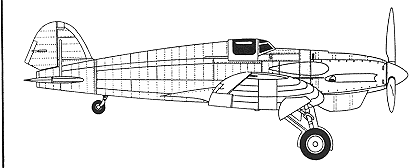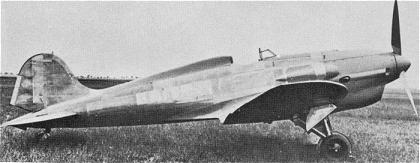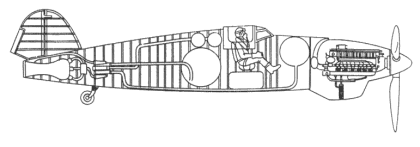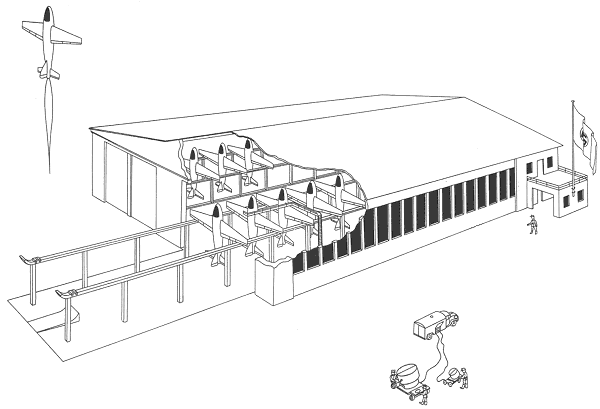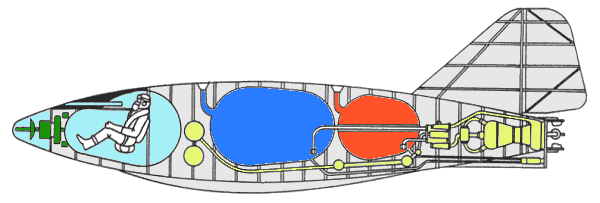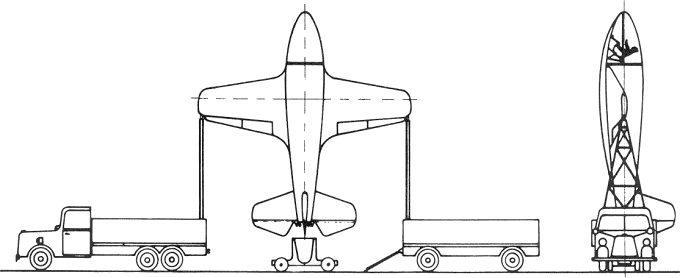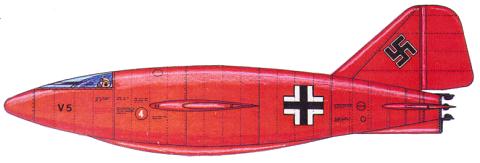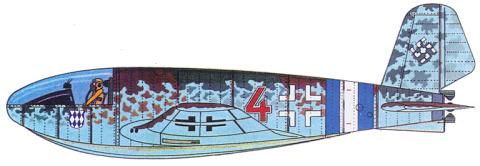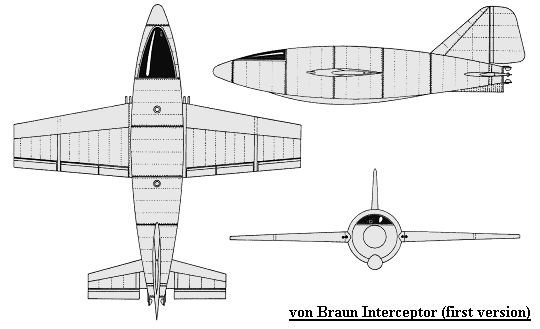 The von Braun Interceptor was of a fairly conventional outline, with a
cigar-shaped fuselage and straight, tapered wings. All the rocket fuel
(alcohol and liquid-oxygen) was stored in tanks behind the cockpit, and
the rocket engine was located in the rear (see cutaway
view below). A single fin and rudder was fitted, along with straight
tailplanes. The pilot was seated in a pressurized cockpit, with an inner
armored section. Take off was a unique and interesting operation. It was
envisioned that the aircraft would be stored vertically in a hanger/launch
facility along two rails. These could then be wheeled by remote control
to the outside, where they would then be launched (see
diagram below). The target would be located by ground radar, and the
interceptor would then be guided for the first minute by graphite vanes
in the rocket exhaust. The pilot then took manual control and changed the
rocket to cruise using an auxiliary combustion chamber. After the attack,
the von Braun interceptor was to glide back to a landing on the built-in
landing skid. The RLM considered this concept too impractical, due to the
at-the-time exotic fuels which were difficult to produce, store and handle.
Plus, there were the specialized launch facilities that had to be constructed
and maintained.
The von Braun Interceptor was of a fairly conventional outline, with a
cigar-shaped fuselage and straight, tapered wings. All the rocket fuel
(alcohol and liquid-oxygen) was stored in tanks behind the cockpit, and
the rocket engine was located in the rear (see cutaway
view below). A single fin and rudder was fitted, along with straight
tailplanes. The pilot was seated in a pressurized cockpit, with an inner
armored section. Take off was a unique and interesting operation. It was
envisioned that the aircraft would be stored vertically in a hanger/launch
facility along two rails. These could then be wheeled by remote control
to the outside, where they would then be launched (see
diagram below). The target would be located by ground radar, and the
interceptor would then be guided for the first minute by graphite vanes
in the rocket exhaust. The pilot then took manual control and changed the
rocket to cruise using an auxiliary combustion chamber. After the attack,
the von Braun interceptor was to glide back to a landing on the built-in
landing skid. The RLM considered this concept too impractical, due to the
at-the-time exotic fuels which were difficult to produce, store and handle.
Plus, there were the specialized launch facilities that had to be constructed
and maintained.
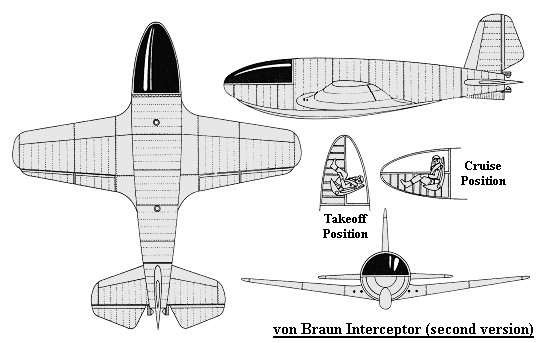 A second version of this VTO interceptor was designed. It was similar to
the first design, except the tail unit was smaller in area, and the wings
now had rounded ends and also exhibited dihedral. Also, the rocket fuels
had been changed to Visol and SV-Stoff, which were easier to store. The
cockpit area was slightly different (see three views to the left). The
launch procedure had been the biggest change however. The huge launch facility
was dispensed with, now the interceptor was launched from the same truck
that was used to transport it (see diagram below).
Both versions were to be armed with four unnamed guns, located two to a
side in the wing roots.
A second version of this VTO interceptor was designed. It was similar to
the first design, except the tail unit was smaller in area, and the wings
now had rounded ends and also exhibited dihedral. Also, the rocket fuels
had been changed to Visol and SV-Stoff, which were easier to store. The
cockpit area was slightly different (see three views to the left). The
launch procedure had been the biggest change however. The huge launch facility
was dispensed with, now the interceptor was launched from the same truck
that was used to transport it (see diagram below).
Both versions were to be armed with four unnamed guns, located two to a
side in the wing roots.
Although this project was not adopted, it did influence Eric Bachem, who later designed and produced his Bachem BP-20 Natter, which was actually flown at least once.
